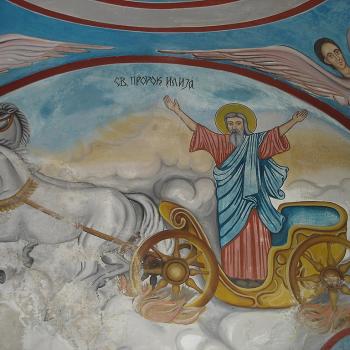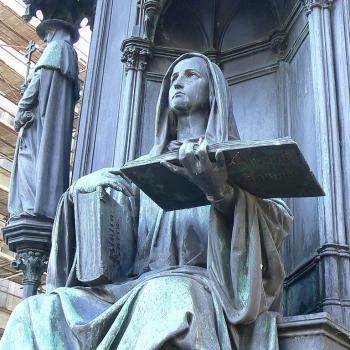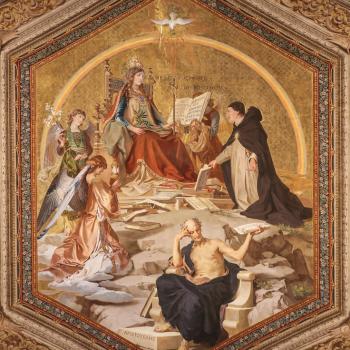![By Anonymous Russian icon painter (before 1917) Public domain image (according to PD-RusEmpire) owned by the Tretyakov Gallery [Public domain], via Wikimedia Commons.](https://wp-media.patheos.com/blogs/sites/637/2016/05/DormitionIcon-250x300.jpg)
The vision of the woman of the Apocalypse, the woman “clothed with the sun,” is the revelation of the eschatological glory Jesus rendered to humanity. The woman who gave birth to the messiah, to the king of kings and God-man, is seen in the heavens, indicating that she has been taken to her rightful place in eternity. With her as our representative, we are shown the glory we are to have in eternity as we become partakers of the divine nature (cf. 2 Ptr. 1:4). She has been taken up into the heavens, where, as the Psalms declare, we are to discern the glory of God:
The heavens are telling the glory of God; and the firmament proclaims his handiwork. Day to day pours forth speech, and night to night declares knowledge. There is no speech, nor are there words; their voice is not heard; yet their voice goes out through all the earth, and their words to the end of the world. In them he has set a tent for the sun, which comes forth like a bridegroom leaving his chamber, and like a strong man runs its course with joy (Ps. 19:1-5 RSV).
The glory of God in the heavens is shown to come down to us and be manifested in the tabernacle, the tent in which the Ark of the Covenant was placed before the construction of the Temple. That tent was placed in the midst of the sun, the light of which served as a figure of the light and glory of God (cf. Hab. 3:4), that is, of Jesus, the light of the world (cf. Jn. 8:12). From this, St. Augustine understood Psalm 19 as a prophetic witness, in figurative form, of the birth of Jesus:
“In the sun has He set His tabernacle.” Now that He might war against the powers of temporal error, the Lord, being about to send not peace but a sword on earth, in time, or in manifestation, set so to say His military dwelling, that is, the dispensation of His incarnation. “And He as a bridegroom coming forth out of His chamber” And He, coming forth out of the Virgin’s womb, where God was united to man’s nature as a bridegroom to a bride. “Rejoiced as a giant to run His way.” Rejoiced as One exceeding strong, and surpassing all other men in power incomparable, not to inhabit, but to run His way. For, “He stood not in the way of sinners.”[1]
What we see in Psalm 19, and its Augustinian interpretation, should allow us to understand its relationship of the glory of the tabernacle with the Ark of the Covenant in it to the woman clothed in the sun in the Apocalypse. The sun’s light clothed the tabernacle, revealing in typological form what would be fulfilled in and through the woman of the Apocalypse. God the Word has tabernacled, or made his tent, with us (cf. Jn 1:14), and in and with his dwelling with humanity, he has been glorified through his death, resurrection and ascension. But now, instead of the Ark of the Mosaic Covenant, his tabernacle, his flesh, contains what the Ark of the Covenant prefigured, the flesh and bloody of Mary. For Jesus took flesh from her flesh, blood from blood, and made it his own as he came to us and tabernacled with us in the incarnation. As the tabernacle was shown to be in the sun, so now the woman which it prefigured, is seen to be in the heavens, clothed in the sun, for by the ascent of Christ, the new Ark of the Covenant was also taken into glory.
By following this kind of typology, many patristic writers were able to explore the significance of Mary’s death and assumption into heaven. Once the feast of her dormition (death) had taken root in the liturgical cycle, this typology would then become reflected in the homilies which were written for the celebration. For example, we can read St. Andrew of Crete making such a connection in his homilies when he proclaimed: “Behold, the new ark of God’s glory, containing, ‘the golden vase, Aaron’s rod that blossomed, and the tabernacle of the covenant’ (Heb 9:4).” [2] With such a foundation, St. Andrew was then able to demonstrate the parallel between the Ark being taken into the Tabernacle with the way Mary was assumed into heaven:
This, O Mother of God, is the hidden meaning of your supernatural dormition. This is the funeral oration that shall accompany the sacred procession of the tent God raised as his tabernacle; the hymn for your passing, the record of the events both proceeding and following your burial, the memorial ode for that transition that surpasses all knowledge. These are but oblique, blurred images of the divine mysteries, the blessed revelations given us about you.[3]
What patristic writers understood concerning the relationship between the Old and New Covenants, between the Old and the New Testament, is important for our theological understanding of Mary. From them, we come to realize how the Old Testament prefigured in typology the glory which was to be fulfilled and given out in eternity through the New Covenant. This is why Jesus was able to say that he came not to destroy the law but to fulfill it, to complete what the whole law represented. For in the law and the prophets, in all that was written, Jesus was being represented (Lk 24:27 – 44; Jn 5:46; Heb 10:1). And because of her connection with Jesus, much of that typology therefore tells us something about Mary. Thus, as David danced around the Ark,[4] so John the Baptist danced with joy in his mother’s womb before the new Ark, Mary.[5] And just as Solomon had the Ark brought into Temple, with much joy and festivity,[6] he did this in anticipation of the true Solomon, Jesus, bringing his mother to the heavenly and eternal temple, as St. John of Damascus elucidated for us:
So now, to bring to its place the spiritual ark not the Lord’s covenant but of the very person of God the Word, the new Solomon himself, King of Peace and master-builder of the universe, called together on this day the sublime ranks of heavenly spirits, and the leaders of the new covenant – I mean the Apostles – with all the holy people in Jerusalem. And he solemnly led her soul, accompanied by angels, into the real and original Holy of Holies in heaven (see Heb 9:12; 10:20), resting on the very wings of the four “living creatures” (Ezek 1:6); he seated her next to his own throne, with the veil where Christ himself, our forerunner, has gone in his own body (cf. Heb 9:12; 10:20). [7]
We can even see the relationship between the funeral procession of Mary, and how her body was carried to her tomb, as similar to the way the Ark was to be carried, not directly, but with specially constructed poles. And just as the Ark was not to be touched, and those who touched it would suffer the consequences of their action, so Mary was not to be defiled as she was placed into her tomb. This, then, explains the legend of the Jewish man who tried to seize her found his hands cut off until he repented and was converted to the Christian faith: it fits with the typology connected to the Ark of the Covenant, and so its significance is best understood in this fashion, and not as an anti-Semitic sentiment.[8]
[1] St. Augustine “On the Psalms” in NPNF1(8): 54-5.
[2] St. Andrew of Crete, “Homily III on the Dormition” in On the Dormition: Early Patristic Homilies. trans. Brian E. Daley, S.J. (Crestwood, NY: St Vladimir’s Seminary Press, 1998), 147.
[3] Ibid., 148.
[4] 2 Sam 6:14
[5] See Joseph Raztinger, Daughter Zion. trans. John M. McDermott, S. J. (San Francisco: Ignatius Press, 1983), 81-2.
[6] See 1 King 8:1-20; 2 Chron 5:2-14.
[7] St John of Damascus, “Homily II on the Dormition” in On the Dormition: Early Patristic Homilies. trans. Brian E. Daley, S.J. (Crestwood, NY: St Vladimir’s Seminary Press, 1998), 216.
[8] See, for example, St John of Damascus, “Homily II on the Dormition,” 216-7.
Stay in touch! Like A Little Bit of Nothing on Facebook:
A Little Bit of Nothing












